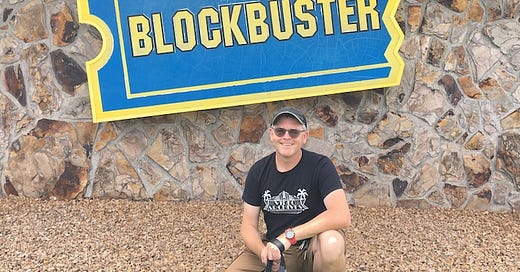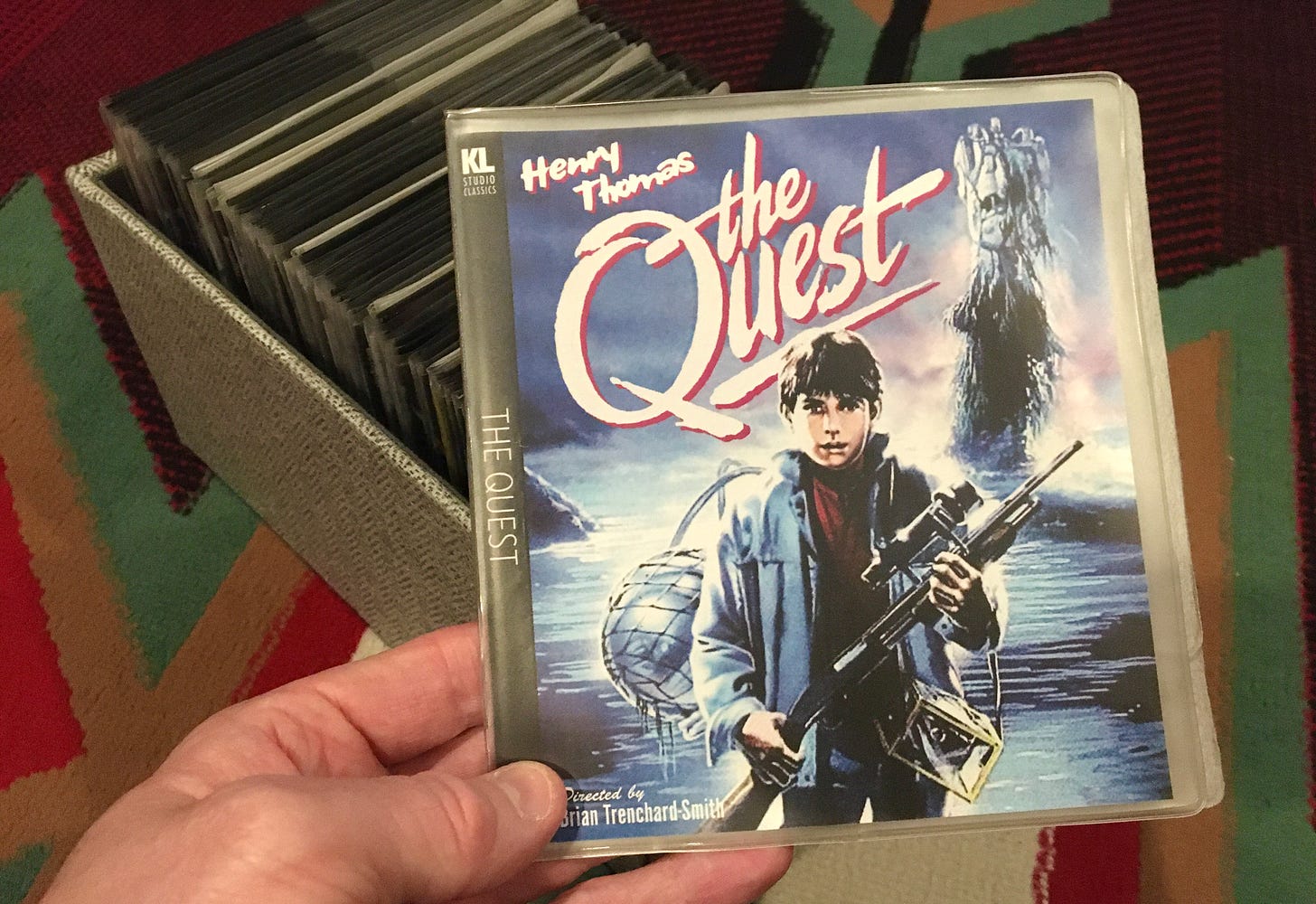Tracy Letts is a famous playwright, screenwriter, and actor. I feel a personal connection to his most-acclaimed work, August Osage County, which is set in Pawhuska, Oklahoma, the site of my family’s farm, and the home of the Osage Indian Tribe (of which I’m a member). I always sit up in my seat a little when Letts appears on screen. (I could watch Ford v Ferrari on an endless loop and never grow tired of his turn as Henry Ford II.) But it wasn’t until I heard his recent interview on The Big Picture podcast that I realized I have more in common with him than I ever imagined.
Letts is an obsessive movie collector, to such a degree that other enthusiasts have dubbed him The King of Physical Media. For anyone of a similar bent, the interview is a must listen, but I must admit, it was a little eye-opening to hear someone discuss the compulsive need to purchase and curate a collection of physical media. It was even more bizarre to listen to another Big Picture episode in which host Sean Fennessey and Veep’s Timothy Simons discussed how one might go about getting into the collecting “lifestyle” and build a collection from scratch. I say “bizarre,” because I’ve been collecting physical media from about as far back as I can remember. I can’t imagine not having this stuff all around me.
Letts has a sense of humor about his collection, which he calls his “sickness,” perhaps because, as he puts it, the plastic cases make it look “like you live in a GameStop." Owing to space constraints, I don’t have that exact problem, the bulk of my titles – save for special editions and Criterion Collection titles – has been removed from their original cases, and are housed in archival sleeves and leather binders. I can however understand the unstated sentiment, a sense that this sort of rampant accumulation feels almost… reckless, but in a time in which mom and pop video stores are a thing of the past, and there’s only one Blockbuster in existence (we made the pilgrimage two years ago), I feel no shame about my collection of physical media (just, please, don’t ask me what it has cost me over the years.).
The scope of my physical media addiction goes beyond movies. As a writer and former bookseller, I have more than my fair share of books stacked around the house in teetering piles, but for the sake of this piece, I’ll ignore the books – as well as the CDs and records – and stick to movies and TV. In the interview, Letts says he has more than 10,000 titles in his carefully organized library. My own collection is a haphazard mess, but I’d guess I have somewhere between 3,500-4,000 discs in mine.
It started with VHS tapes. As I’ve said in the past, my family didn’t own a VCR until I was twelve years old. Technically, my family never had a VCR, as it wasn’t until my parents split up and my mother and I moved to Massachusetts that we were given a player as a gift. My first movie purchase was a broken copy of Octopussy, which I bought from the $1 bin in a rental store across the border in New Hampshire. That was an easy fix, once I unscrewed the case and scotch-taped the magnetic tape back onto the reel, it played perfectly. I just had to rewind it carefully. My first Bond title was quickly joined by used copies of Ghostbusters II, Indiana Jones and the Last Crusade, and Batman (all of which I used to watch repeatedly at my friend Kevin Mann’s house.)
Last summer, as I was packing my things to go to Oklahoma, I realized some things never change. My backpack (the same one I’ve carried since my sophomore year in high school) was once more stuffed full of books and movies. This was the case whenever I flew back and forth for visits with Dad in New Mexico. During summers in Farmington, I worked a few days a week at a two-way radio business, where I would sweep up the dried mud that crumbled from the police cars, fire engines, and oil drilling trucks that came into the warehouse to have their equipment serviced. The money from that job would go to movie theater tickets, and of course, to buying VHS tapes. On the days I wasn’t working, I would inevitably head out on foot in search of bargains. I could buy terrible public domain copies of Roger Corman movies like the original Little Shop of Horrors for pennies on the dollar at Walgreens, along with brand new releases of Disney titles like Pinocchio. Smith’s grocery store across the street was a treasure trove of virtually unwatched Woody Allen titles. That’s also where I picked up Psycho III, an inexplicable impulse purchase, seeing as the end of Psycho II had disturbed me so thoroughly that I had to sleep on the floor of my father’s bedroom afterward (I won’t even tell you how old I was at the time). Days later, unable to sleep with that copy of Psycho III sitting on my movie stacks, I climbed out my bedroom window in the middle of the night and ran down the street to a construction site, where I smashed the tape to pieces with a shovel and threw it in a dumpster. Looking back on it, it’s crazy that being in the same room with that tape – Norman Bates leering out from the front of the box as he held out the key to cabin 1 – was more terrifying to me than the idea of running through the deserted nighttime streets, where I might have encountered coyotes or God knows what or who else. (To this day, other than a few of the Scream titles, if you’re looking for horror movies, they’re the one genre you won’t find in my collection.) At the end of each summer, my backpack and duffel bag would be packed full of tapes, with my clothing just barely crammed into whatever space was left.
In middle school, the one upside to hellish overnight hiking trips with the local Boy Scout troop was that we usually stopped for dinner at the McDonalds in Middletown on the way back, that’s where, for a glorious period in the early 90s, I could get $5.99 copies of Paramount titles likes Raiders of the Lost Ark, Ghost, The Addams Family, and Wayne’s World along with the purchase of a burger. Once I started working at the bookstore in high school, my money went to car insurance, gas money, financing for my own low-budget filmmaking efforts, and, you guessed it… more movies. Around 1995, I started collecting Laserdiscs, which usually cost between $30 and $40 and were the premium format until my freshman year of college, when DVD hit the market. DVDs averaged $20 a title, the image was every bit as good as Laserdisc, and they took up a fraction of the space. That’s when things began to snowball.
From January of 1998 onward, I was continually on the hunt for new and used DVDs: All through my years at RIT; In the strange period after my college graduation and 9/11, when I returned to my old job at the bookstore; In 2002, when I moved to Tacoma and worked on old houses with my sister. All this while, I was working, trying to figure out what to do with my life, and collecting movies. I moved up to Seattle in 2003, where I worked first at Starbucks Corporate, and later as an Editor at the University of Washington. On hot summer days, when I couldn’t stand the idea of sitting on the bus from the U-District to Greenwood, I would often walk home, inevitably stopping at Hollywood Video in search of bargains.
When Steph and I got married in October of 2007, our friend Matt gave us an X-Box 360 with a HD DVD add-on unit. That was my first step into HD media collecting. A couple months later, I applied for a job at a website called High-Def Digest, which at the time was the top site of its kind (it’s subsequently been destroyed by budget cuts and a series of shockingly incompetent redesigns). The High Definition format war was at its peak, and my pitch to HDD’s publisher was that I had an HD DVD player, but I suspected the competing format would win, because “Blu-ray” just sounded more unique. I was right. And I got the job. I was the Editor-in-Chief of High-Def Digest for almost ten years. For a physical media addict, it was heaven. The bulk of my collection was accumulated in the that period, during which time HD DVD died, Blu-ray soared, Blu-ray 3D became a thing, then wasn’t, and Ultra HD Blu-rays eventually became the gold standard for physical movie collectors.
With my days at the helm of High-Def Digest behind me, I focused on writing my books, raising our daughter (some of Charley’s first words were “Streaming is terrible.”). I continued collecting of course, but by that point, I was primarily waiting for long-awaited titles like Manhattan Murder Mystery and Wonder Boys to finally be released in HD. Since the pandemic, the entertainment industry has never entirely recovered, which has greatly reduced the number of new titles hitting movie screens and home video. That’s been good for my budget, as there are far fewer new titles that I feel the need to purchase immediately. These days, I’m mostly replacing my favorite titles with 4K rereleases, but only if they truly offer an upgrade. Of course, steelbooks and special editions are always a temptation. But as interviews with Letts and others make clear, the home video business has changed. For collectors, it’s sort of a golden period, with better technology readily available, and remastered and restored titles rolling out every month, but the market is different. The best releases these days are running much closer to $40 and $50+, above and beyond the cost of Laserdiscs thirty years ago. The majority of consumers have inexplicably unloaded their DVD collections and willingly put themselves at the mercy of streaming services, where they have to wait and see what assortment of titles Netflix and the others have secured from one month to next. For those of us who feel compelled to own our favorite movies in the cuts and transfers they prefer, it’s never been more important to maintain a physical collection.

Physical movies have moved into a world once reserved for vinyl record collectors, they’re fetish items. I could pass judgment on someone dropping $40 on a piece of early 90s dreck like Demolition Man, but to paraphrase John Cusack in High Fidelity, “I’m… kinda one of them.”
If you're enjoying Shelf Talkers by Mike Attebery, you might enjoy Mike's books, which you can find at the online retailer of your choice by following this link









